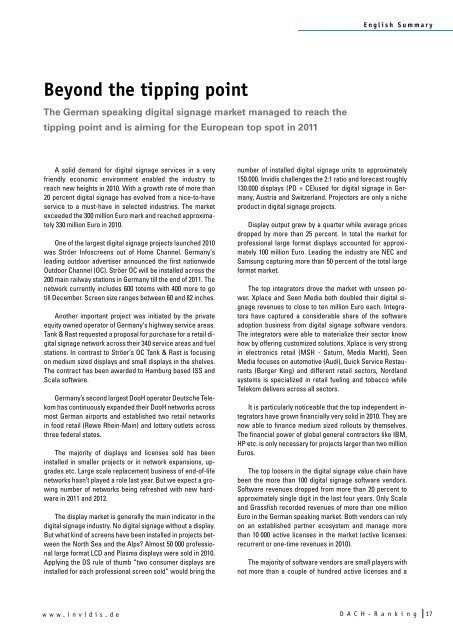Digital Signage- Markt 2010 Dossier Deutschland - Dimedis
Digital Signage- Markt 2010 Dossier Deutschland - Dimedis
Digital Signage- Markt 2010 Dossier Deutschland - Dimedis
Sie wollen auch ein ePaper? Erhöhen Sie die Reichweite Ihrer Titel.
YUMPU macht aus Druck-PDFs automatisch weboptimierte ePaper, die Google liebt.
Beyond the tipping point<br />
The German speaking digital signage market managed to reach the<br />
tipping point and is aiming for the european top spot in 2011<br />
A solid demand for digital signage services in a very<br />
friendly economic environment enabled the industry to<br />
reach new heights in <strong>2010</strong>. With a growth rate of more than<br />
20 percent digital signage has evolved from a nice-to-have<br />
service to a must-have in selected industries. The market<br />
exceeded the 300 million Euro mark and reached approximately<br />
330 million Euro in <strong>2010</strong>.<br />
One of the largest digital signage projects launched <strong>2010</strong><br />
was Ströer Infoscreens out of Home Channel. Germany‘s<br />
leading outdoor advertiser announced the first nationwide<br />
Outdoor Channel (OC). Ströer OC will be installed across the<br />
200 main railway stations in Germany till the end of 2011. The<br />
network currently includes 600 totems with 400 more to go<br />
till December. Screen size ranges between 60 and 82 inches.<br />
Another important project was initiated by the private<br />
equity owned operator of Germany‘s highway service areas.<br />
Tank & Rast requested a proposal for purchase for a retail digital<br />
signage network across their 340 service areas and fuel<br />
stations. In contrast to Ströer‘s OC Tank & Rast is focusing<br />
on medium sized displays and small displays in the shelves.<br />
The contract has been awarded to Hamburg based ISS and<br />
Scala software.<br />
Germany’s second largest DooH operator Deutsche Telekom<br />
has continuously expanded their DooH networks across<br />
most German airports and established two retail networks<br />
in food retail (Rewe Rhein-Main) and lottery outlets across<br />
three federal states.<br />
The majority of displays and licenses sold has been<br />
installed in smaller projects or in network expansions, upgrades<br />
etc. Large scale replacement business of end-of-life<br />
networks hasn’t played a role last year. But we expect a growing<br />
number of networks being refreshed with new hardware<br />
in 2011 and 2012.<br />
The display market is generally the main indicator in the<br />
digital signage industry. No digital signage without a display.<br />
But what kind of screens have been installed in projects between<br />
the North Sea and the Alps? Almost 50 000 professional<br />
large format LCD and Plasma displays were sold in <strong>2010</strong>.<br />
Applying the DS rule of thumb “two consumer displays are<br />
installed for each professional screen sold” would bring the<br />
w w w . i n v i d i s . d e<br />
E n g l i s h S u m m a r y<br />
number of installed digital signage units to approximately<br />
150.000. Invidis challenges the 2:1 ratio and forecast roughly<br />
130.000 displays (PD + CE)used for digital signage in Germany,<br />
Austria and Switzerland. Projectors are only a niche<br />
product in digital signage projects.<br />
Display output grew by a quarter while average prices<br />
dropped by more than 25 percent. In total the market for<br />
professional large format displays accounted for approximately<br />
100 million Euro. Leading the industry are NEC and<br />
Samsung capturing more than 50 percent of the total large<br />
format market.<br />
The top integrators drove the market with unseen power.<br />
Xplace and Seen Media both doubled their digital signage<br />
revenues to close to ten million Euro each. Integrators<br />
have captured a considerable share of the software<br />
adoption business from digital signage software vendors.<br />
The integrators were able to materialize their sector know<br />
how by offering customized solutions. Xplace is very strong<br />
in electronics retail (MSH - Saturn, Media <strong>Markt</strong>), Seen<br />
Media focuses on automotive (Audi), Quick Service Restaurants<br />
(Burger King) and different retail sectors, Nordland<br />
systems is specialized in retail fueling and tobacco while<br />
Telekom delivers across all sectors.<br />
It is particularly noticeable that the top independent integrators<br />
have grown financially very solid in <strong>2010</strong>. They are<br />
now able to finance medium sized rollouts by themselves.<br />
The financial power of global general contractors like IBM,<br />
HP etc. is only necessary for projects larger than two million<br />
Euros.<br />
The top loosers in the digital signage value chain have<br />
been the more than 100 digital signage software vendors.<br />
Software revenues dropped from more than 20 percent to<br />
approximately single digit in the last four years. Only Scala<br />
and Grassfish recorded revenues of more than one million<br />
Euro in the German speaking market. Both vendors can rely<br />
on an established partner ecosystem and manage more<br />
than 10 000 active licenses in the market (active licenses:<br />
recurrent or one-time revenues in <strong>2010</strong>).<br />
The majority of software vendors are small players with<br />
not more than a couple of hundred active licenses and a<br />
D A C H - R a n k i n g<br />
17


